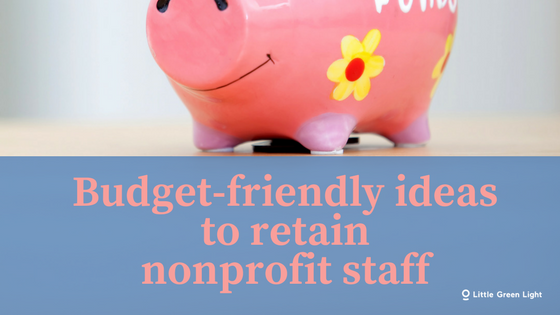Little Green Light is a cloud-based donor management system for fundraisers.
Subscribe to get our latest product updates, best practices and tips to grow your nonprofit.

A few years ago, I arrived bleary-eyed at my desk the morning after a big event hosted by the nonprofit organization I worked for. I was tired out from the months of preparation and from the event itself, but as any fundraiser knows there’s still plenty of follow-up work to be done after an event, too.
My eyes brightened when I saw an envelope with my name on it. Inside was a gift card to the local ice cream shop. Along with it, the executive director had written a note of thanks for my hard work and encouraged me to enjoy the warm weather by taking a break for an ice cream treat. It was a thoughtful and seemingly small gesture that each staff member was treated to that morning—but it was also indicative of an organizational culture that cared for its employees and was mindful of providing us with non-monetary benefits. We worked hard, and we also felt appreciated and respected.
These non-monetary benefits and actions by leaders like the ones I experienced are incredibly important for nonprofit employees, for whom salaries tend to be low. In 2013, a national study exploring challenges facing the nonprofit sector confirmed that there are high levels of turnover throughout the sector and lengthy vacancies in development positions. Of course, it’s not just development positions that are vulnerable to high turnover. Program staff and administrative staff are also plagued with a revolving door. This phenomenon strains organizations’ ability to achieve their missions.
I wanted to learn how nonprofits of any size can implement strategies to retain staff, so I reached out to Laura Weinman of Kistner Eddy Executive Services (KEES). Laura has more than 20 years of experience with development staff recruitment and staff management. She loves supporting the nonprofit sector by helping to build transformative teams so they can do what they do best, change the world for the better! Laura shared a wealth of information.
First, the cost of turnover:
KEES’ research found the cost of turnover to be 150% of the vacant position’s salary. Why so high? There are a number of key factors:
Thankfully, the following proven strategies help with both preventing turnover and retaining existing staff.
Determine what a competitive wage is for your organization and for the position you’re filling. Laura recommends conducting a salary study to get a sense of an appropriate salary range. What do other organizations in your geographic area pay? When hiring staff, trying to get a bargain will likely backfire on you. Equally as important, you don’t want to disrupt your salary scale for one person; otherwise, you may have a harder time retaining the rest of your staff.
Even with limited budgets, there are plenty of non-monetary benefits that you can provide, such as:
Talk to employees about what interests them, and provide them with opportunities to grow:
Conclusion
Replacing staff takes time and money away from your mission. By implementing some of these practical tips from Laura Weinman, you can retain staff and increase the effectiveness of your organization. Last but not least, thanks to Laura for sharing her expertise!
Ready to try LGL? Get your first 30 days free. No credit card required.